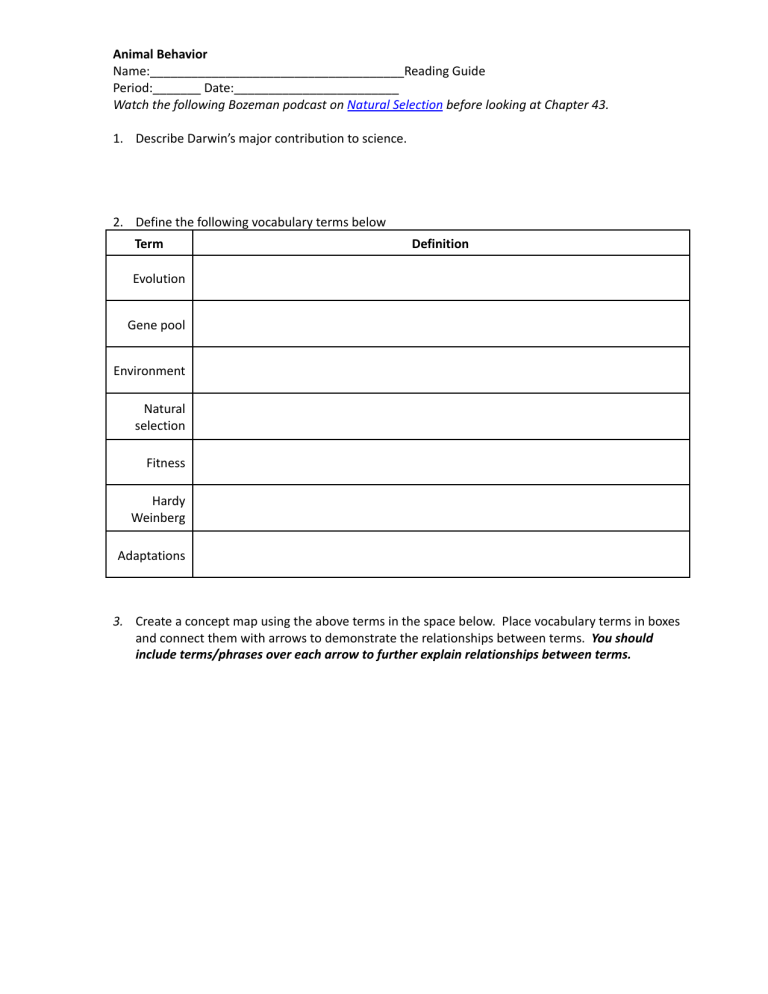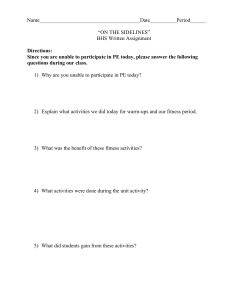Animal Behavior Reading Guide
advertisement

Animal Behavior Name:_____________________________________Reading Guide Period:_______ Date:________________________ Watch the following Bozeman podcast on Natural Selection before looking at Chapter 43. 1. Describe Darwin’s major contribution to science. 2. Define the following vocabulary terms below Term Definition Evolution Gene pool Environment Natural selection Fitness Hardy Weinberg Adaptations 3. Create a concept map using the above terms in the space below. Place vocabulary terms in boxes and connect them with arrows to demonstrate the relationships between terms. You should include terms/phrases over each arrow to further explain relationships between terms. 4. Summarize how the process of natural selection has worked on the following two populations of organisms. Bacteria Peppered Moth 5. Defend the statement that adaptation is a process. Use the African cichlids from the Rift Valley to support your reasoning. Use the information included in Chapter 43 on Animal Behavior to complete the following reading guide. Bozeman’s Animal Behavior podcast may also be helpful. Discrete sensory inputs can stimulate both simple and complex behavior 1. Behavior is an action carried out by muscles under control of the nervous system in response to a stimulus. Behavioral ecology is concerned with: ● Proximate cause 🡪 ● Ultimate cause 🡪 2. Describe the relationship between a fixed action pattern and a sign stimulus? Give an example. 3. How do various environmental stimuli (position of sun, magnetic field) trigger and provide cues about migration? a. Differentiate between circadian and circannual rhythms. 4. Signals are stimuli that cause a change in the behavior of another individual and are the basis of animal communication. a. Discuss the role of visual, chemical, tactile, and auditory communication in the stimulus-response chain of Drosophila melanogaster (fruit fly) courtship. b. Describe how honeybees (Apis mellifera) engage in complex forms of communication concerning the location of their food. c. Discuss two examples of how pheromones may be used by animals to communicate. Learning Establishes specific links between experience and behavior 1. Define and describe an example of an innate behavior in an animal. 2. The environment can influence behavior through learning, the modification of behavior based on specific experiences. a. Discuss how a twin study can give us insight into both genetics and behavior. b. Explain the importance of a sensitive period during imprinting. c. Discuss one example of associative learning in an animal. 3. Choose one innate and one learned animal behavior and explain how each increases the fitness of an organism. Selection for individual survival and reproductive success can explain most behaviors 1. Behaviors are selected for the advantages they provide for survival and reproduction. a. Discuss the compromise between the benefits of nutrition and the cost of obtaining food proposed by the optimal foraging model. b. Describe the characteristics of each of the following mating systems. ● Promiscuous 🡪 ● Monogomous 🡪 ● Polygamous 🡪 c. Which of the above mating systems would be most advantageous to a species that produces helpless young that require food delivered to them? Explain. Inclusive fitness can account for the evolution of behavior, including altruism 1. Natural selection is not perfect. Often there are trade-offs. Discuss how altruism, inclusive fitness, and kin selection illustrate this concept.



